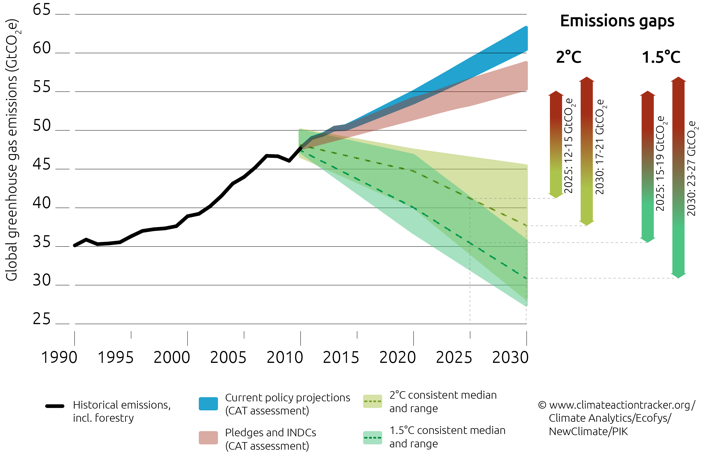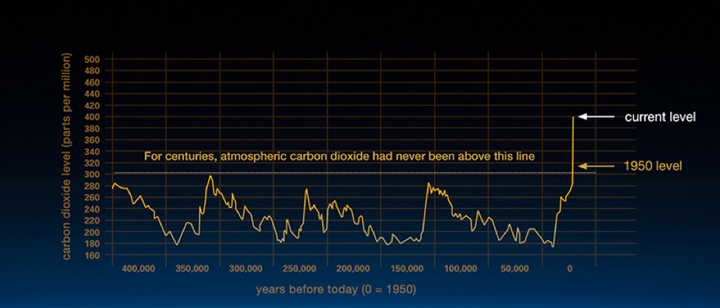To stabilize climate, we theoretically need to drive green-house-gas – especially carbon – emissions down to zero. Indeed, the more green-house gases there are in the atmosphere, the more heat is trapped, and the warmer our planet is.
It is a vicious circle:
- the more CO2 we pump out in the atmosphere – by burning fossil fuels, by cutting out trees,
- the hotter our planet is,
- the quicker ice caps melt,
- the higher the rise in sea levels,
But most importantly:
- the more green-house gases are released – especially methane contained in the permafrost, which is 34 times stronger than CO2 at trapping heat over 100 years and 86 times over 20 years,
- the hotter our planet is,
- etc.
Although the world agreed at COP21 to limit temperature rise by 2.0°C, current trends suggest that it is very unlikely that we reach this target and that bringing green-house-gas emissions to a halt is completely out of scope. Even the best-case scenario is built on the assumption that we would emit about 25Gt of carbon dioxide equivalent globally by 2030 – compared to roughly 50 in 2015.

Indeed, the goal of zero-emissions is not desirable: the path to zero-emissions must be progressive and in line with the progress of carbon-neutral fuels such as hydro, solar and wind. Otherwise, it would mean going back to the stone age overnight! Nor will zero-emissions be enough to reign in climate change.
The reason why bringing down emissions – even to zero – will not be enough to stabilize the climate and why focusing exclusively on renewable is kind of missing the point, is because the level of carbon dioxide in the atmosphere is already particularly unsafe. NASA scientists can tell that these levels are higher than they have been at any time in the past 400,000 years. Today’s concentration of CO2 in the atmosphere – above 400ppm – is comparable to this during the Eemian period, a time much warmer than what Homo Sapiens ever experimented and when sea levels were between 20 and 30 feet higher than currently observed.

Facing this reality, there is a consensus amongst the scientific community, and increasingly amongst governments, that we must achieve “negative emissions” to return to atmospheric carbon dioxide levels considered as safe – most agree under 350ppm. In other words, we must develop revolutionary technologies to remove existing and accumulating carbon dioxide from the atmosphere. Carbon capture and sequestration technologies are not new, but so far few have delivered on their promise.
First, CO2 storage is expensive: “it still costs nothing to spew CO2 into the sky, so people have no financial incentive to stop dumping, let alone pay to clean up the air” according to the climate specialist Oliver Geden. In order to promote carbon capture technologies, including them in renewable energy tax credit is an appealing option. Indeed, tax credits are efficient vectors of adoption: in the US for instance, federal tax credits for renewables have served as one of the primary financial incentives for their deployment over the last two decades. However, another major issue with CO2 storage is that it is intended to be permanent and therefore intrinsically carries the risk of a leakage that might contaminate ground water or injure people.
However, all hope is not lost. A recent ground-breaking discovery made by researchers at Columbia University’s Lamont-Doherty Earth Observatory might be a game-changer in the field of carbon-sucking technologies. The scientists discovered how to quickly transform the planet-warming gas into a mineral by making it react with a type of rock that is abundantly available from the Earth’s mantle. A project that would inject millions of tons of carbon dioxide into the basalt of the Pacific Northwest is already underway. Further encouraging is that Global Thermostat, a private company led by one of the Columbia scientists, is monetizing the benefits of this transformative technology and creating a market for captured carbon dioxide. And as history shows, a technology that is economically profitable is much more likely to succeed where other have failed.
The focus on renewable energies and the efforts to make hydro, wind and PV technologies more efficient are critical, but even more important is to scale up the development of carbon-negative technologies. To do so, governments must step in and heavily subsidize R&D in the field, and must make carbon capture technologies more affordable for the end-customer through tax credits for instance.
While our fears and hopes rise with the temperature, keeping an eye on the unique Global Thermostat solution and other carbon capture technologies is key to keeping our heads cool.
